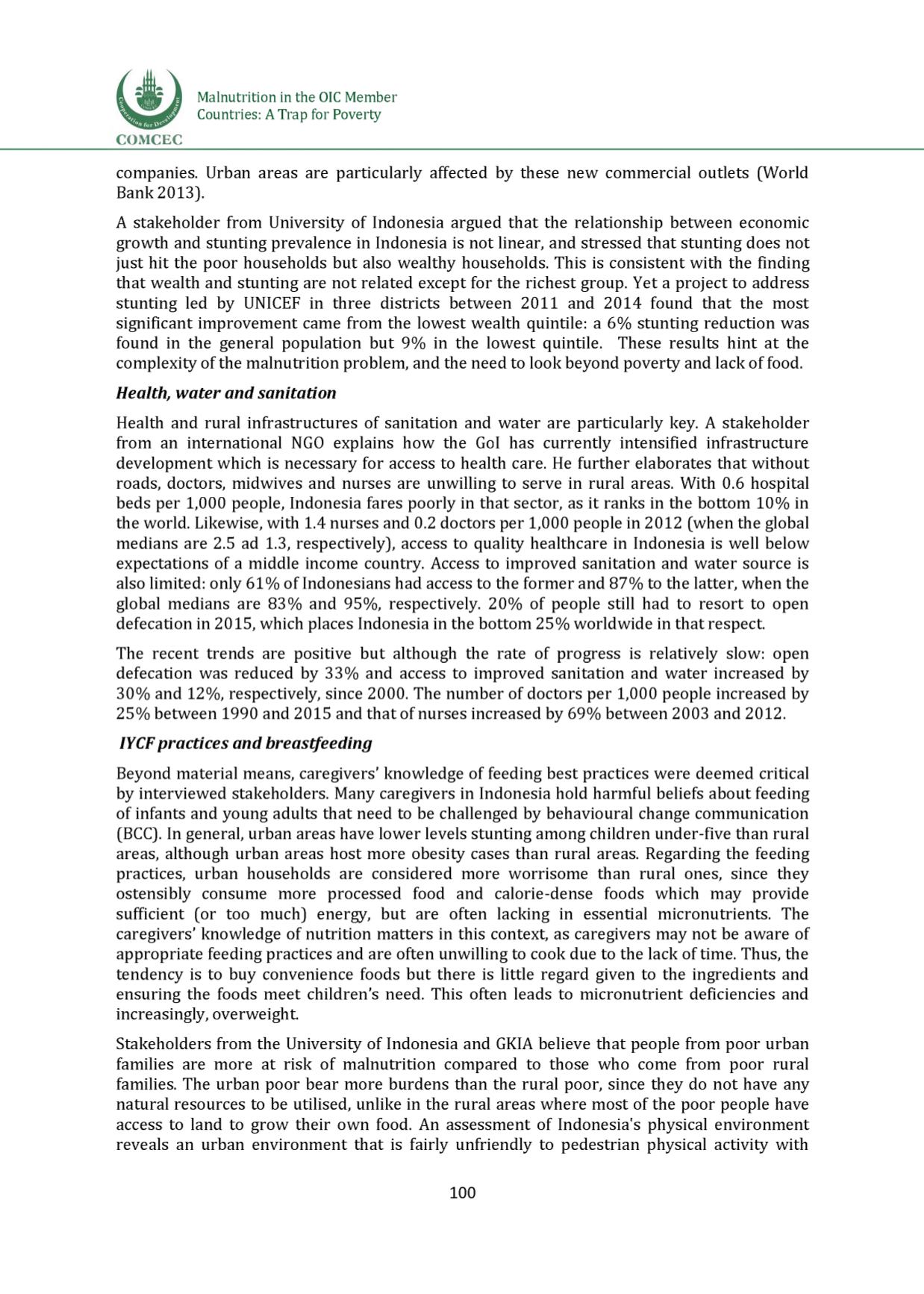

COMCEC
Malnutrition in the OIC Member
Countries: A Trap for Poverty
companies. Urban areas are particularly affected by these new commercial outlets (World
Bank 2013).
A stakeholder from University of Indonesia argued that the relationship between economic
growth and stunting prevalence in Indonesia is not linear, and stressed that stunting does not
just hit the poor households but also wealthy households. This is consistent with the finding
that wealth and stunting are not related except for the richest group. Yet a project to address
stunting led by UNICEF in three districts between 2011 and 2014 found that the most
significant improvement came from the lowest wealth quintile: a
6
% stunting reduction was
found in the general population but 9% in the lowest quintile. These results hint at the
complexity of the malnutrition problem, and the need to look beyond poverty and lack of food.
Health, water and sanitation
Health and rural infrastructures of sanitation and water are particularly key. A stakeholder
from an international NGO explains how the GoI has currently intensified infrastructure
development which is necessary for access to health care. He further elaborates that without
roads, doctors, midwives and nurses are unwilling to serve in rural areas. With 0.6 hospital
beds per 1,000 people, Indonesia fares poorly in that sector, as it ranks in the bottom 10% in
the world. Likewise, with 1.4 nurses and 0.2 doctors per 1,000 people in 2012 (when the global
medians are 2.5 ad 1.3, respectively), access to quality healthcare in Indonesia is well below
expectations of a middle income country. Access to improved sanitation and water source is
also limited: only 61% of Indonesians had access to the former and 87% to the latter, when the
global medians are 83% and 95%, respectively. 20% of people still had to resort to open
defecation in 2015, which places Indonesia in the bottom 25% worldwide in that respect.
The recent trends are positive but although the rate of progress is relatively slow: open
defecation was reduced by 33% and access to improved sanitation and water increased by
30% and 12%, respectively, since 2000. The number of doctors per 1,000 people increased by
25% between 1990 and 2015 and that of nurses increased by 69% between 2003 and 2012.
IYCFpractices and breastfeeding
Beyond material means, caregivers' knowledge of feeding best practices were deemed critical
by interviewed stakeholders. Many caregivers in Indonesia hold harmful beliefs about feeding
of infants and young adults that need to be challenged by behavioural change communication
(BCC). In general, urban areas have lower levels stunting among children under-five than rural
areas, although urban areas host more obesity cases than rural areas. Regarding the feeding
practices, urban households are considered more worrisome than rural ones, since they
ostensibly consume more processed food and calorie-dense foods which may provide
sufficient (or too much) energy, but are often lacking in essential micronutrients. The
caregivers' knowledge of nutrition matters in this context, as caregivers may not be aware of
appropriate feeding practices and are often unwilling to cook due to the lack of time. Thus, the
tendency is to buy convenience foods but there is little regard given to the ingredients and
ensuring the foods meet children's need. This often leads to micronutrient deficiencies and
increasingly, overweight.
Stakeholders from the University of Indonesia and GKIA believe that people from poor urban
families are more at risk of malnutrition compared to those who come from poor rural
families. The urban poor bear more burdens than the rural poor, since they do not have any
natural resources to be utilised, unlike in the rural areas where most of the poor people have
access to land to grow their own food. An assessment of Indonesia's physical environment
reveals an urban environment that is fairly unfriendly to pedestrian physical activity with
100
















